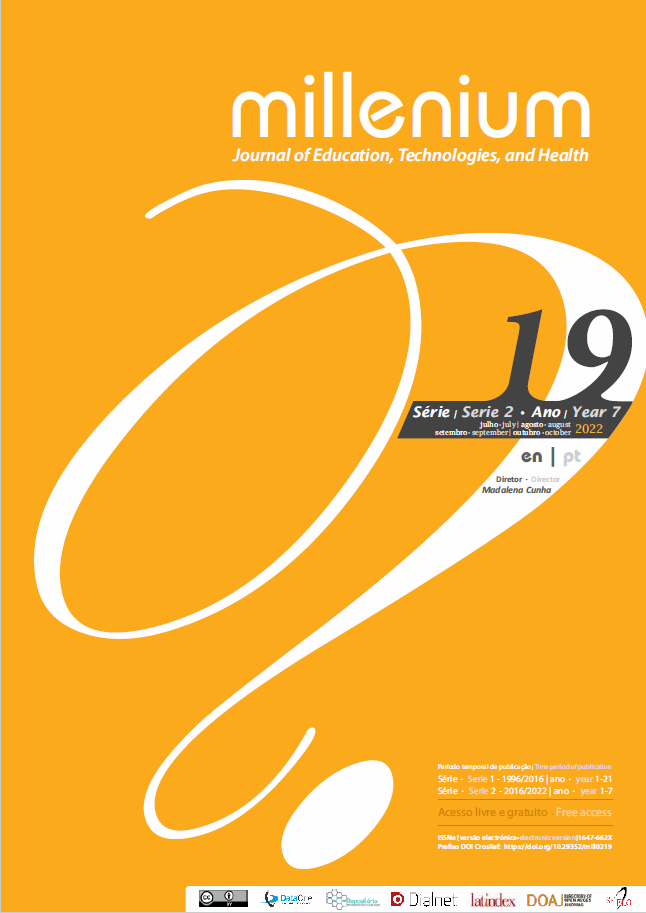Bullying and the banalization of evil
an analysis of teenagers speech
DOI:
https://doi.org/10.29352/mill0219.27821Keywords:
bullying, critical discourse analysis (cda), violence, banality of evil, teachingAbstract
Introduction: This work is the result of research, productions and actions by the Research Group Humanities and Contemporary Society (GPHSC), from the Federal Institute of Mato Grosso (IFMT) on the phenomenon of school bullying with a view to empowerment. Bullying is characterized by being a systematic violence in which there is inequality of power, therefore, not all violence at school is bullying, but all bullying is violence and causes suffering to those involved.
Objectives: To describe and identify emancipatory as well as oppressive discourses about the fight against bullying.
Methods: The qualitative approach was adopted for this study and for data collection, an online questionnaire was applied with unstructured and structured answer questions. In this study, we analysed the responses of 42 adolescents aged 15 to 18 years, 23 female students and 19 male students, obtained in a teaching institution of the federal network and discussed, specifically, the following question: Is there a suggestion to stop bullying? The analysis of the collected data was interpreted through Critical Discourse Analysis (CDA) theoretically based on Hanna Arendt's concept of banality of evil.
Results: It was found in the students' answers, speeches that translate the symbolic discourses in the school environment, answers that indicated a critical/emancipatory view on combating bullying, as well as the perpetuation of discourses of violence and oppression of victims and aggressors.
Conclusions: It was possible to envision possibilities for interpreting students' discourses about combating bullying and these can corroborate actions aimed at youth leadership as a way to critically contextualize the issue of school violence and thus enable ways to mitigate this phenomenon.
Downloads
References
Abramovay, M. (2006). Cotidiano das escolas: Entre violências. Brasília: UNESCO, Observatório de Violência, Ministério da Educação.
Bock, A. M. B., Furtado, O., & Teixeira, M. de L. T. (2018). Psicologias: Uma introdução ao estudo de psicologia (15ª ed.). S. Paulo: Saraiva. https://edisciplinas.usp.br/pluginfile.php/5615614/mod_resource/content/1/bock_psicologias.pdf
Brasil, Presidência da República. Secretaria-Geral, Subchefia para Assuntos Jurídicos (2015, Novembro, 09). Lei nº 13.185, de 6 de novembro de 2015, Institui o Programa de Combate à Intimidação Sistemática (Bullying). Diário Oficial da União[da] República Federativa do Brasil, 50 (213), pp. 1-2. http://www.planalto.gov.br/ccivil_03/_Ato2015-2018/2015/Lei/L13185.htm
Ciavatta, M. (2014). Emancipação: A historicidade do conceito e a polêmica no processo real da existência humana. Revista Trabalho Necessário, 12(18), 74-97. https://periodicos.uff.br/trabalhonecessario/article/view/8593/6156
Fairclough, N. (2010). Discurso e mudança social. Brasília: Universidade de Brasília.
Guareschi, P. A. (2001). Pressupostos psicossociais da exclusão: Competitividade e culpabilização. In B. Sawaia (Org.), As artimanhas da exclusão: análise psicossocial e ética da desigualdade social (pp. 52-60). Petrópolis: Vozes.
Harari, Y. (2018). 21 lições para o século 21. S. Paulo: Companhia das Letras.
Martins, C. H. B. (2003). Trabalhadores na reciclagem do lixo: Dinâmicas econômicas, socioambientais e políticas na perspectiva de empoderamento (Tese de doutoramento, Universidade Federal do Rio Grande do Sul). https://lume.ufrgs.br/handle/10183/6190
Medeiros, A. V. M. (2012). O fenômeno bullying: (In) definições do termo e suas possibilidades (Dissertação de mestrado, Universidade Federal de Goiás). https://files.cercomp.ufg.br/weby/up/789/o/2012_-_Alexandre_MALMANN_-_Disserta%C3%A7%C3%A3o_-FINALIZADA.pdf
Minayo, M. C. de S. (2012). Pesquisa social: teoria método e criatividade (21ª ed.). S. Paulo: Vozes.
Mota, R. M. F. (2017). Violação dos direitos humanos e bullying no contexto escolar: Diagnóstico e proposta de intervenção com base no empoderamento dos alunos. Cuiabá: Instituto Federal de Mato Grosso.
Paoliello, S. R. & Fernandes, R.M. (2020). Representações discursivas de adolescentes no combate ao bullying. Polifonia, 27 (42), 48-67. https://periodicoscientificos.ufmt.br/ojs/index.php/polifonia/article/view/8927
Resende, V. de M. & Ramalho, V. (2017). Análise do Discurso Crítica (2ª. ed). São Paulo: Contexto.
Santos, K. D. S., Fernandes, R. M., Grecco, L., Santos, B. P. d., Santos, C. C. R., & Silva, I. C. (2021). A banalização do mal e a representação dos discursos de adolescentes no combate ao bullying. New Trends in Qualitative Research,7, 172-180. https://doi.org/10.36367/ntqr.7.2021.172-180
Silva, V. C. G. (2019). Violência Escolar, Bullying e Violação de Diretos Humanos no Cotidiano Escolar. Cuiabá: Instituto Federal de Mato Grosso.
Souki, N. (1998). Hannah Arendt e a banalidade do mal. Belo Horizonte: Editora Universidade Federal de Minas Gerais.
Downloads
Published
How to Cite
Issue
Section
License
Copyright (c) 2022 Millenium - Journal of Education, Technologies, and Health

This work is licensed under a Creative Commons Attribution 4.0 International License.
Authors who submit proposals for this journal agree to the following terms:
a) Articles are published under the Licença Creative Commons (CC BY 4.0), in full open-access, without any cost or fees of any kind to the author or the reader;
b) The authors retain copyright and grant the journal right of first publication, allowing the free sharing of work, provided it is correctly attributed the authorship and initial publication in this journal;
c) The authors are permitted to take on additional contracts separately for non-exclusive distribution of the version of the work published in this journal (eg, post it to an institutional repository or as a book), with an acknowledgment of its initial publication in this journal;
d) Authors are permitted and encouraged to publish and distribute their work online (eg, in institutional repositories or on their website) as it can lead to productive exchanges, as well as increase the impact and citation of published work
Documents required for submission
Article template (Editable format)





